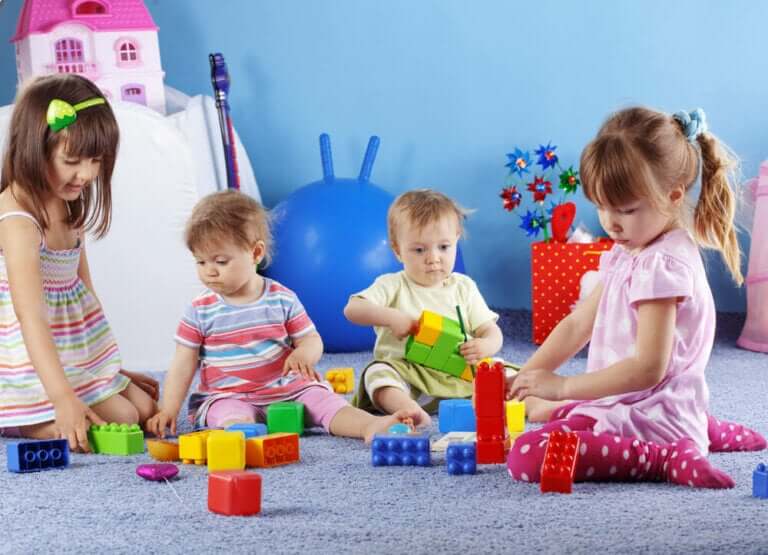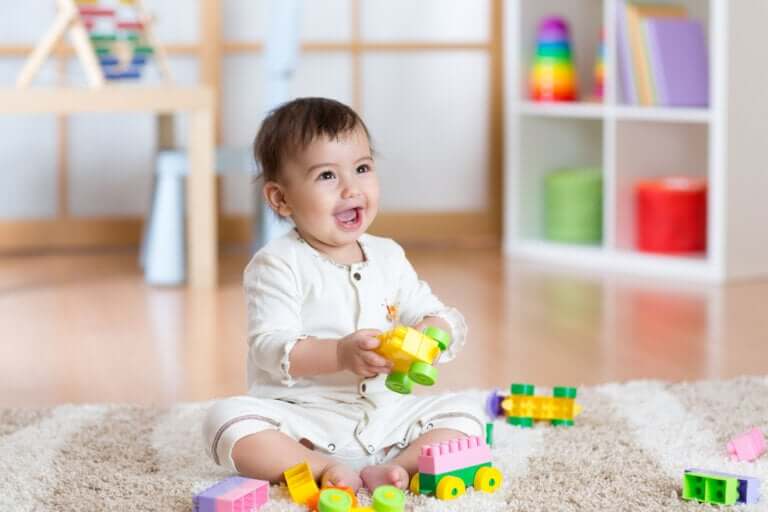Games to Work on Children's Motor Skills

Using games to work on children’s motor skills is an excellent and very necessary tool. However, people generally don’t place much emphasis on this until a child goes to school. From that age, children are introduced to sports and exercise, but the emphasis tends to be more on talent and competitiveness than on their integral development as human beings.
However, motor skills are essential for a child’s correct biological, psychological and social development. So, if we wait until the beginning of schooling to work on it, then up to five years of opportunities in a child’s life will be lost in this respect.
What is motor development?
Motor development encompasses a whole series of changes that occur in a person’s motor skills. By carrying them out, the child will be progressively more able to carry out new and diverse motor actions efficiently. In addition to this, they’ll begin to control their bodies’ movements and adapt better to their physical and social environment.
A person will develop motor skills in a practical way from birth to adulthood. However, it’s important to know the different evolutionary stages a child passes through in order to offer them the most suitable stimulation at each stage of their development. To facilitate this, we’re going to group the different games according to the different ages that they’re aimed at.

Games to work on children’s motor skills
3 to 6 months
Leave the child on a rug and give them several different colored cups (of a suitable material). Then, encourage them to build towers by placing them on top of each other. This simple activity enhances your child’s fine and gross motor skills and coordination.
Place a musical piano in the child’s crib where their feet are. In this way, when they’re lying down, they’ll be able to “play” the keys with their feet and enjoy the sounds. This musical stimulus will enhance their movements and encourage them to continue. This exercise game will encourage the development of the baby’s gross motor skills.
6 to 9 months
From this age onwards, circuits or routes with different “obstacles” are an excellent tool. The idea is that the little one will crawl through the different objects. Mats and tunnels are ideal for this, but if you don’t have any, then it will be enough just to use your imagination and use anything that’s fit for the purpose.
You can also use cushions at different heights or boxes open on both sides. Why not place a toy at the end of the route and encourage your child to move towards it? This activity will strengthen their crawling and enhance their gross motor skills.
To work on fine motor skills it’s extremely beneficial to give your child small building blocks of different shapes and sizes. While sitting on the floor they’ll simply have to play with them, creating towers or stacking them any way they want.
9 to 12 months
To improve their fine motor skills and hand-eye coordination, we can work with small balls of different colors. By placing several containers on the floor, we can challenge the child to put as many balls as possible in the container in a given time. Alternatively, we could ask them to put all the balls of the same color in a certain box.

12 to 15 months
Choose two small toys with wheels (this could be a car, train, truck, etc.) – one for yourself and one for your child. Then, sitting on the carpet, roll your toy in such a way that you mark out a route. The child, with their own toy, will have to try to follow the same path. Then the roles change and the child will mark out the first route and you will follow. We can also use large cards and draw on them the path that the toys will follow.
Additionally, if we use toys the child can drag while standing up, then we’ll be working on their gross motor skills and helping them learn to walk.
Matryoshka dolls are also very useful objects that can help them to develop their fine motor skills at this age. The adult just needs to show the child how to use them and then let their child experiment with them.
These are just some ideas for activities that parents can carry out at home to work on their children’s motor skills. Don’t wait until they start school to stimulate their motor skills!
Using games to work on children’s motor skills is an excellent and very necessary tool. However, people generally don’t place much emphasis on this until a child goes to school. From that age, children are introduced to sports and exercise, but the emphasis tends to be more on talent and competitiveness than on their integral development as human beings.
However, motor skills are essential for a child’s correct biological, psychological and social development. So, if we wait until the beginning of schooling to work on it, then up to five years of opportunities in a child’s life will be lost in this respect.
What is motor development?
Motor development encompasses a whole series of changes that occur in a person’s motor skills. By carrying them out, the child will be progressively more able to carry out new and diverse motor actions efficiently. In addition to this, they’ll begin to control their bodies’ movements and adapt better to their physical and social environment.
A person will develop motor skills in a practical way from birth to adulthood. However, it’s important to know the different evolutionary stages a child passes through in order to offer them the most suitable stimulation at each stage of their development. To facilitate this, we’re going to group the different games according to the different ages that they’re aimed at.

Games to work on children’s motor skills
3 to 6 months
Leave the child on a rug and give them several different colored cups (of a suitable material). Then, encourage them to build towers by placing them on top of each other. This simple activity enhances your child’s fine and gross motor skills and coordination.
Place a musical piano in the child’s crib where their feet are. In this way, when they’re lying down, they’ll be able to “play” the keys with their feet and enjoy the sounds. This musical stimulus will enhance their movements and encourage them to continue. This exercise game will encourage the development of the baby’s gross motor skills.
6 to 9 months
From this age onwards, circuits or routes with different “obstacles” are an excellent tool. The idea is that the little one will crawl through the different objects. Mats and tunnels are ideal for this, but if you don’t have any, then it will be enough just to use your imagination and use anything that’s fit for the purpose.
You can also use cushions at different heights or boxes open on both sides. Why not place a toy at the end of the route and encourage your child to move towards it? This activity will strengthen their crawling and enhance their gross motor skills.
To work on fine motor skills it’s extremely beneficial to give your child small building blocks of different shapes and sizes. While sitting on the floor they’ll simply have to play with them, creating towers or stacking them any way they want.
9 to 12 months
To improve their fine motor skills and hand-eye coordination, we can work with small balls of different colors. By placing several containers on the floor, we can challenge the child to put as many balls as possible in the container in a given time. Alternatively, we could ask them to put all the balls of the same color in a certain box.

12 to 15 months
Choose two small toys with wheels (this could be a car, train, truck, etc.) – one for yourself and one for your child. Then, sitting on the carpet, roll your toy in such a way that you mark out a route. The child, with their own toy, will have to try to follow the same path. Then the roles change and the child will mark out the first route and you will follow. We can also use large cards and draw on them the path that the toys will follow.
Additionally, if we use toys the child can drag while standing up, then we’ll be working on their gross motor skills and helping them learn to walk.
Matryoshka dolls are also very useful objects that can help them to develop their fine motor skills at this age. The adult just needs to show the child how to use them and then let their child experiment with them.
These are just some ideas for activities that parents can carry out at home to work on their children’s motor skills. Don’t wait until they start school to stimulate their motor skills!
All cited sources were thoroughly reviewed by our team to ensure their quality, reliability, currency, and validity. The bibliography of this article was considered reliable and of academic or scientific accuracy.
- Uribe Pareja, I. D. (1998). Motricidad infantil y desarrollo humano.
- Morán, A. M. M. (2017). Desarrollo de la motricidad fina y gruesa en etapa infantil. Sinergias educativas, 2(2), 10-20.
This text is provided for informational purposes only and does not replace consultation with a professional. If in doubt, consult your specialist.








